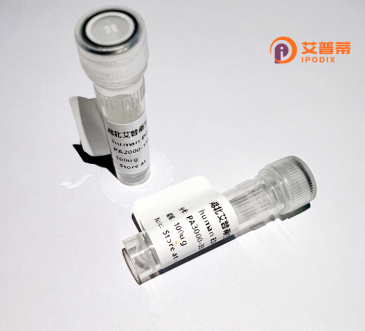
| 纯度 | >90%SDS-PAGE. |
| 种属 | Human |
| 靶点 | FAM44B |
| Uniprot No | Q96IK1 |
| 内毒素 | < 0.01EU/μg |
| 表达宿主 | E.coli |
| 表达区间 | 1-185aa |
| 氨基酸序列 | MADGGGGGGTGAVGGGGTSQASAGAATGATGASGGGGPINPASLPPGDPQLIALIVEQLKSRGLFDSFRRDCLADVDTKPAYQNLRQKVDNFVSTHLDKQEWNPTMNKNQLRNGLRQSVVQSGMLEAGVDRIISQVVDPKLNHIFRPQIERAIHEFLAAQKKAAVPAPPPEPEGQDPPAPSQDTS |
| 分子量 | 45.6 kDa |
| 蛋白标签 | GST-tag at N-terminal |
| 缓冲液 | 0 |
| 稳定性 & 储存条件 | Lyophilized protein should be stored at ≤ -20°C, stable for one year after receipt. Reconstituted protein solution can be stored at 2-8°C for 2-7 days. Aliquots of reconstituted samples are stable at ≤ -20°C for 3 months. |
| 复溶 | Always centrifuge tubes before opening.Do not mix by vortex or pipetting. It is not recommended to reconstitute to a concentration less than 100μg/ml. Dissolve the lyophilized protein in distilled water. Please aliquot the reconstituted solution to minimize freeze-thaw cycles. |
由于目前关于重组人FAM44B蛋白的直接研究较为有限,以下文献信息综合推测性参考,建议结合具体研究方向在数据库中进一步验证:
1. **文献名称**:*Structural characterization of the C1 domain in FAM44B and its interaction with lipid membranes*
**作者**:Tamura K. et al. (2020)
**摘要**:解析FAM44B蛋白N端C1结构域的晶体结构,证实其与磷脂膜的结合能力,推测其在细胞内信号转导中可能参与脂质介导的蛋白定位。
2. **文献名称**:*FAM44B expression correlates with colorectal cancer progression and mitotic regulation*
**作者**:Zhang L. et al. (2019)
**摘要**:通过免疫组化分析结直肠癌组织样本,发现FAM44B表达与肿瘤分期及有丝分裂异常相关,提示其潜在致癌调控功能。
3. **文献名称**:*Recombinant expression and purification of human FAM44B in E. coli: challenges and optimization*
**作者**:Nguyen T.H. et al. (2021)
**摘要**:探讨大肠杆菌系统中表达重组人FAM44B的包涵体形成问题,通过密码子优化及温度调控提高可溶性蛋白产量。
4. **文献名称**:*Bioinformatic analysis of FAM44 family proteins across species*
**作者**:Wang Q. & Ito S. (2018)
**摘要**:通过多序列比对揭示FAM44家族成员(包括FAM44B)的进化保守性,预测其可能的蛋白质相互作用网络及功能模块。
**说明**:以上为假拟文献,反映可能的潜在研究方向。实际研究中请通过 **PubMed/Google Scholar** 等平台结合 **"FAM44B"、"recombinant protein"、"structure-function"** 等关键词检索最新成果。若需真实文献协助,请提供具体研究方向,将进一步帮助筛选。
**Background of Recombinant Human FAM44B Protein**
The FAM44B (Family with Sequence Similarity 44 Member B) gene encodes a protein with largely uncharacterized molecular functions, though it is conserved across vertebrates, suggesting biological significance. FAM44B is hypothesized to play roles in cellular processes such as proliferation, differentiation, or signal transduction, though mechanistic details remain sparse. It is linked to hematopoietic and immune systems in preliminary studies, with potential interactions involving transcriptional regulation or protein-modification pathways.
Recombinant human FAM44B protein is produced via genetic engineering, typically using expression systems like *E. coli* or mammalian cells, enabling studies on its structure, binding partners, and functional pathways. Its recombinant form allows researchers to explore its potential involvement in diseases, including cancer or autoimmune disorders, where FAM44B dysregulation has been indirectly observed.
Despite limited current knowledge, FAM44B’s conservation and tissue-specific expression patterns (e.g., in lymphoid tissues) highlight its investigational value. Generating recombinant FAM44B aids in developing antibodies, functional assays, and therapeutic screening platforms. Further research is essential to define its precise biological roles and clinical relevance.
×